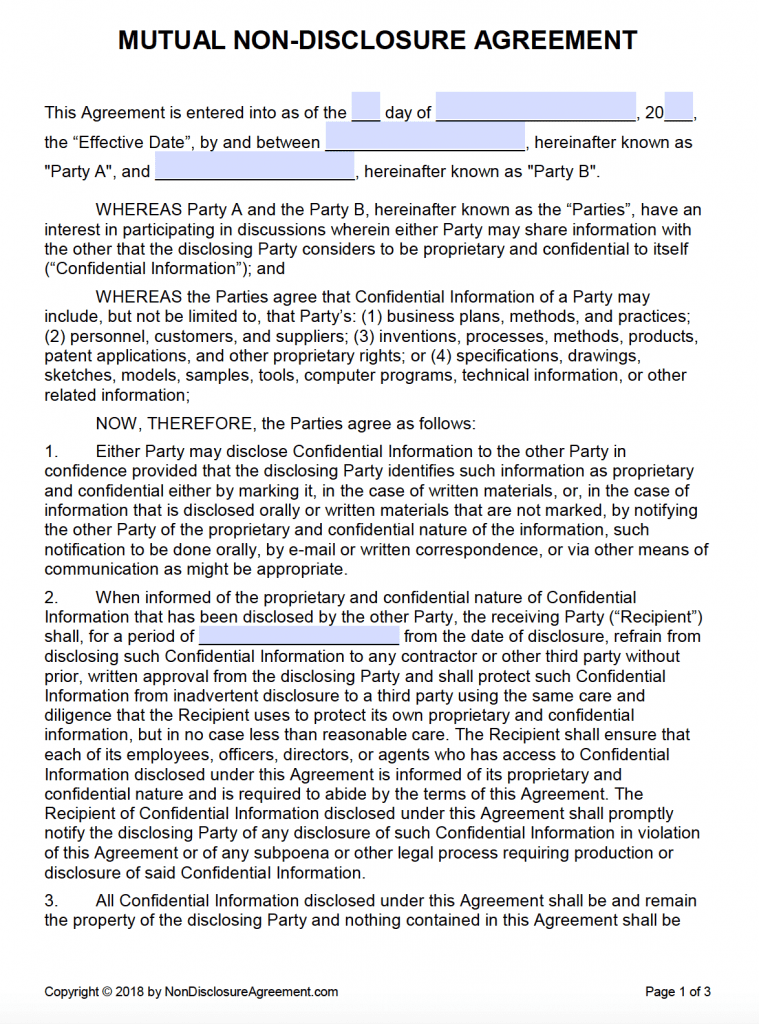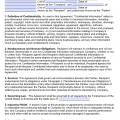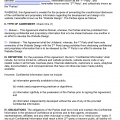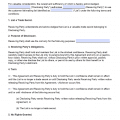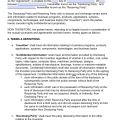Mutual Non-Disclosure Agreement (NDA)

The mutual non-disclosure agreement is intended for situations when two parties are contemplating an agreement, and each discloses confidential information to the other — for example, when one company contemplates purchasing another, or when an innovator and manufacturer are considering working together. If both sides are disclosing secrets to each other you should use this mutual (or “bilateral”) nondisclosure agreement. When providing confidential information it should be labeled as “confidential.”
Unilateral NDA – Unlike a mutual (2-way) agreement, in a unilateral NDA only one (1) party is bound to keep the proprietary information a secret.
Sample
MUTUAL NONDISCLOSURE AGREEMENT
This Mutual Nondisclosure agreement (the “Agreement”) is entered into by and between ______________ and _________________ collectively referred to as the “parties” for the purpose of preventing the unauthorized disclosure of Confidential Information as defined below. The parties agree to enter into a confidential relationship with respect to the disclosure by one or each (the “Disclosing Party”) to the other (the “Receiving Party”) of certain proprietary and confidential information (the “Confidential Information”).
1. Definition of Confidential Information
For purposes of this Agreement, “Confidential Information” shall include all information or material that has or could have commercial value or other utility in the business in which Disclosing Party is engaged. If Confidential Information is in written form, the Disclosing Party shall label or stamp the materials with the word “Confidential” or some similar warning. If Confidential Information is transmitted orally, the Disclosing Party shall promptly provide a writing indicating that such oral communication constituted Confidential Information.
2. Exclusions from Confidential Information
Receiving Party’s obligations under this Agreement do not extend to information that is: (a) publicly known at the time of disclosure or subsequently becomes publicly known through no fault of the Receiving Party; (b) discovered or created by the Receiving Party before disclosure by Disclosing Party; (c) learned by the Receiving Party through legitimate means other than from the Disclosing Party or Disclosing Party’s representatives; or (d) is disclosed by Receiving Party with Disclosing Party’s prior written approval.
3. Obligations of Receiving Party
Receiving Party shall hold and maintain the Confidential Information in strictest confidence for the sole and exclusive benefit of the Disclosing Party. Receiving Party shall carefully restrict access to Confidential Information to employees, contractors and third parties as is reasonably required and shall require those persons to sign nondisclosure restrictions at least as protective as those in this Agreement. Receiving Party shall not, without prior written approval of Disclosing Party, use for Receiving Party’s own benefit, publish, copy, or otherwise disclose to others, or permit the use by others for their benefit or to the detriment of Disclosing Party, any Confidential Information. Receiving Party shall return to Disclosing Party any and all records, notes, and other written, printed, or tangible materials in its possession pertaining to Confidential Information immediately if Disclosing Party requests it in writing.
This Agreement and Receiving Party’s duty to hold Confidential Information in confidence shall remain in effect until _________________ or until whichever of the following occurs first: (a) Disclosing Party sends Receiving Party written notice releasing it from this Agreement, or (b) Confidential Information disclosed under this Agreement ceases to be confidential.
Nothing contained in this Agreement shall be deemed to constitute either party a partner, joint venturer or employee of the other party for any purpose.
If a court finds any provision of this Agreement invalid or unenforceable, the remainder of this Agreement shall be interpreted so as best to effect the intent of the parties.
This Agreement expresses the complete understanding of the parties with respect to the subject matter and supersedes all prior proposals, agreements, representations and understandings. This Agreement may not be amended except in a writing signed by both parties.
The failure to exercise any right provided in this Agreement shall not be a waiver of prior or subsequent rights.
This Agreement and each party’s obligations shall be binding on the representatives, assigns and successors of such party.
Each party has signed this Agreement through its authorized representative.
_____________________________________________________ (Signature)
___________________________ (Typed or Printed Name)
Date: _______________
_____________________________________________________ (Signature)
___________________________ (Typed or Printed Name)
Date: _______________
How to Write
EXPLANATION FOR MUTUAL NONDISCLOSURE AGREEMENT
Below we provide an explanation for each of the provisions in the Mutual Nondisclosure Agreement.
Introductory Paragraph
Fill in the names of both parties. If either of the parties is a business, not an individual, use the proper name of the business and designate if it is a partnership, LLC or corporation (for example, “Mindgrown, Inc., a California corporation.”)
1. Confidential Information
This section defines what is protected against disclosure. Keep in mind that whoever discloses secrets, should designate that information as confidential. If the information is spoken, the discloser should announce the confidentiality.
2. Exclusions
This provision describes all the types of information that are not covered by the agreement. These exclusions are based on court decisions and state trade secret laws that say these types of information do not qualify for trade secret protection.
3. Obligations
This clause makes clear that the secrets must be kept in confidence by the receiving party and may not be revealed to others without prior written consent.
4. Term
This clause provides the parties with an expiration date for the agreement. The agreement should last as long as the information is likely to remain a trade secret. Five years is a common period, but it can be much shorter, even as little as six months. In Internet and technology businesses, the time period may need to be shorter because of the fast pace of innovation.
5. Relationships
Most agreements include a provision like this one, disclaiming any relationship other than that defined in the agreement.
6. Severability
The severability clause provides that if the parties wind up in a lawsuit over the agreement and a court rules that one part of the agreement is invalid, that part can be cut out and the rest of the agreement will remain valid.
7. Integration
The integration provision verifies that the version you are signing is the final version and that neither of you can rely on statements made in the past.
8. Waiver
This provision states that even if you don’t promptly complain about a violation of the NDA, you still have the right to complain about it later.
9. Successors and Assigns
This provision binds any company that acquires either party.
Signing the agreement. Someone with the necessary authority must sign the agreement on behalf of each party. Each party should sign two copies and keep one. This way, both parties have an original signed agreement.
